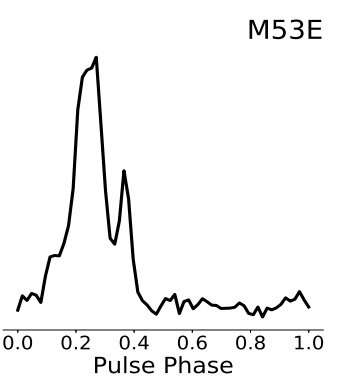June 26, 2023 report
This article has been reviewed according to Science X's editorial process and policies. Editors have highlighted the following attributes while ensuring the content's credibility:
fact-checked
preprint
trusted source
proofread
New millisecond pulsar detected with FAST

Using the Five-hundred-meter Aperture Spherical radio Telescope (FAST), a team of Chinese astronomers has detected a new millisecond pulsar in the globular cluster Messier 53. The finding is reported in a research paper published June 16 on the pre-print server arXiv.
Pulsars are highly magnetized, rotating neutron stars emitting a beam of electromagnetic radiation. The most rapidly rotating pulsars, with rotation periods below 30 milliseconds, are known as millisecond pulsars (MSPs). Astronomers assume that they are formed in binary systems when the initially more massive component turns into a neutron star that is then spun up due to accretion of matter from the secondary star.
Globular clusters (GCs) are collections of tightly bound stars orbiting galaxies. They have extraordinarily dense stellar environments, making them excellent places to form X-ray binary systems of millisecond pulsars.
Located some 58,350 light years away, Messier 53 (also known as M53 or NGC 5024) is so far the most distant GC with known pulsars. The cluster is about 12.67 billion years old, has a mass of approximately 826,000 solar masses, and a metallicity of -2.1, which makes it one of the most metal-poor GCs in the Milky Way. To date, four pulsars have been detected in Messier 53, and three of them turned out to be MSPs.
Now, a group of astronomers led by Yujie Lian of the Beijing Normal University in China, reports the discovery of another MSP in this cluster. The detection was made using the center beam of the FAST 19-beam L-band receiver.
"The tracking observation of M53 was initiated on November 30, 2019, as the pilot survey for the FAST GC pulsar survey and SP2 project 4 (Pan et al. 2021)," the researchers wrote in the paper.
The newfound pulsar received designation PSR J1312+1810E (or M53E). It has a spin period of about 3.97 milliseconds and dispersion measure of approximately 25.88 pc/cm3. The orbital period of M53E was found to be 2.43 days.
The companion object in the system is most likely a white dwarf with an estimated mass of at least 0.18 solar masses. The surface magnetic field strength of M53E was measured to be not greater than 140 million Gauss and the pulsar's characteristic age was calculated to be more than 13 billion years.
Besides the detection of M53E, FAST observations also allowed Lian's team to investigate the three other MSPs in the Messier 53 cluster. They found that one of them is an isolated pulsar, while the other two are binary systems with white dwarf companions slightly more massive than the one in M53E. All in all, the results show characteristics of this pulsar population are similar to the population of MSPs in the Milky Way's disk.
More information: Yujie Lian et al, Discovery and Timing analysis of new pulsars in globular cluster NGC 5024: new observations from FAST, arXiv (2023). DOI: 10.48550/arxiv.2306.09741
Journal information: arXiv
© 2023 Science X Network





















